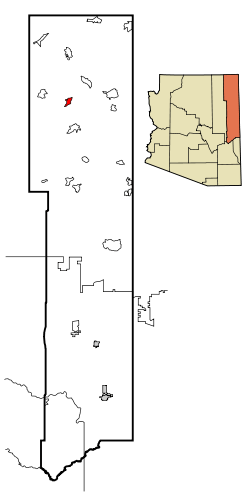Many Farms, Arizona
Many Farms (Navajo: Dáʼákʼeh Halání) is a census-designated place (CDP) in Apache County, Arizona, United States. The population was 1,348 at the 2010 census.[3]
Many Farms, Arizona | |
|---|---|
 Location in Apache County and the state of Arizona | |
 Many Farms, Arizona Location in the United States | |
| Coordinates: 36°21′36″N 109°37′41″W | |
| Country | United States |
| State | Arizona |
| County | Apache |
| Area | |
| • Total | 8.18 sq mi (21.18 km2) |
| • Land | 8.15 sq mi (21.12 km2) |
| • Water | 0.03 sq mi (0.06 km2) |
| Elevation | 5,307 ft (1,618 m) |
| Population (2010) | |
| • Total | 1,348 |
| • Estimate (2016)[2] | N/A |
| Time zone | UTC-7 (MST) |
| ZIP code | 86538 |
| Area code | 928 |
| FIPS code | 04-44200 |
| GNIS feature ID | 0007659 |
Geography
Many Farms is located at 36°21′36″N 109°37′41″W (36.359870, -109.628053).[4]
According to the United States Census Bureau, the CDP has a total area of 8.2 square miles (21.2 km2), of which 8.1 square miles (21.1 km2) is land and 0.039 square miles (0.1 km2), or 0.30%, is water.[3]
Climate
According to the Köppen Climate Classification system, Many Farms has a semi-arid climate, abbreviated "BSk" on climate maps.[5]
History
Many Farms is an English translation of the Navajo name of the area and is descriptive. The farms became fully irrigated in 1937.[6]
From 1952 to 1962, the Many Farms community was the location of two major medical experiments led by Walsh McDermott. The goal of the first experiment was to test the efficacy of the drug isoniazid as a treatment for tuberculosis, which was then widespread and largely fatal among the Navajo despite the availability of TB medication elsewhere in the country. McDermott chose the reservation because he needed a population that had not been previously exposed to streptomycin, then the most advanced treatment for TB. While McDermott's initial TB experiment was a success, his second experiment, in which he attempted a more broad-based healthcare intervention, failed to meaningfully reduce disease morbidity and mortality among the Navajo due to conflicts with the Indian Health Service, as well as the experiment's inability to address poverty, which was the underlying cause of most disease.[7]
Demographics
| Historical population | |||
|---|---|---|---|
| Census | Pop. | %± | |
| 2000 | 1,548 | — | |
| 2010 | 1,348 | −12.9% | |
| U.S. Decennial Census[8] | |||
As of the census[9] of 2000, there were 1,548 people, 433 households, and 313 families residing in the CDP. The population density was 188.2 people per square mile (72.7/km²). There were 606 housing units at an average density of 73.7/sq mi (28.5/km²). The racial makeup of the CDP was 88.37% Native American, 7.82% White, 0.32% Black or African American, 0.13% Asian, 0.32% from other races, and 3.04% from two or more races. 2.07% of the population were Hispanic or Latino of any race.
There were 433 households out of which 48.7% had children under the age of 18 living with them, 44.6% were married couples living together, 23.1% had a female householder with no husband present, and 27.7% were non-families. 24.9% of all households were made up of individuals and 2.5% had someone living alone who was 65 years of age or older. The average household size was 3.58 and the average family size was 4.39.
In the CDP, the age distribution of the population shows 42.4% under the age of 18, 9.6% from 18 to 24, 26.7% from 25 to 44, 18.2% from 45 to 64, and 3.2% who were 65 years of age or older. The median age was 23 years. For every 100 females, there were 92.8 males. For every 100 females age 18 and over, there were 91.8 males.
The median income for a household in the CDP was $30,089, and the median income for a family was $31,316. Males had a median income of $32,566 versus $25,945 for females. The per capita income for the CDP was $9,995. About 28.2% of families and 31.7% of the population were below the poverty line, including 37.9% of those under age 18 and 53.6% of those age 65 or over.
Education
Many Farms is a part of the Chinle Unified School District.[10]
Many Farms Public School (K-8), is in the area considered to be Many Farms. The district also operates Chinle High School.
In addition, the U.S. Bureau of Indian Affairs's Office of Education Programs operates the Many Farms High School in the Many Farms area.[11]
References
- "2016 U.S. Gazetteer Files". United States Census Bureau. Retrieved Jul 18, 2017.
- "Population and Housing Unit Estimates". Retrieved June 9, 2017.
- "Geographic Identifiers: 2010 Demographic Profile Data (G001): Many Farms CDP, Arizona". U.S. Census Bureau, American Factfinder. Archived from the original on February 12, 2020. Retrieved April 19, 2013.
- "US Gazetteer files: 2010, 2000, and 1990". United States Census Bureau. 2011-02-12. Retrieved 2011-04-23.
- Climate Summary for Many Farms, Arizona
- Byrd H. Granger (1960). Arizona Place Names. University of Arizona Press. p. 15. Retrieved 5 December 2011.
- Jones, David (2002). "The Health Care Experiments at Many Farms: The Navajo, Tuberculosis, and the Limits of Modern Medicine, 1952-1962". Bulletin of the History of Medicine. 76 (4): 749–790. doi:10.1353/bhm.2002.0186. PMID 12446978.
- "Census of Population and Housing". Census.gov. Retrieved June 4, 2016.
- "U.S. Census website". United States Census Bureau. Retrieved 2008-01-31.
- "SCHOOL DISTRICT REFERENCE MAP (2010 CENSUS): Apache County, AZ" (PDF). 2010 U.S. Census. U.S. Census Bureau. Retrieved 2020-04-08. - Chinle USD is depicted on pages 1 and 2.
- "National Directory June 2015" (Archive). Bureau of Indian Education. p. 16/44. Retrieved on June 16, 2015.
